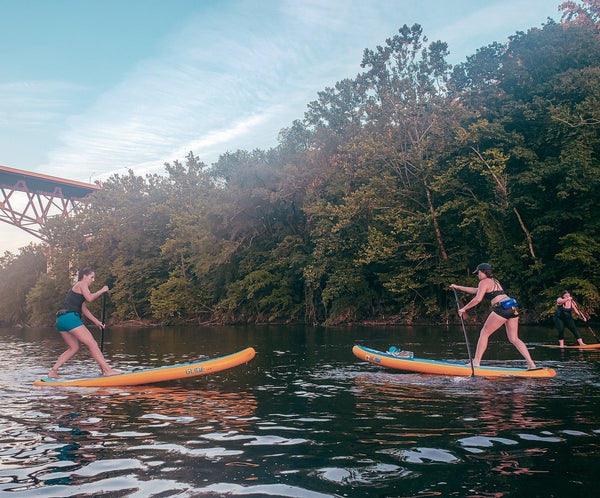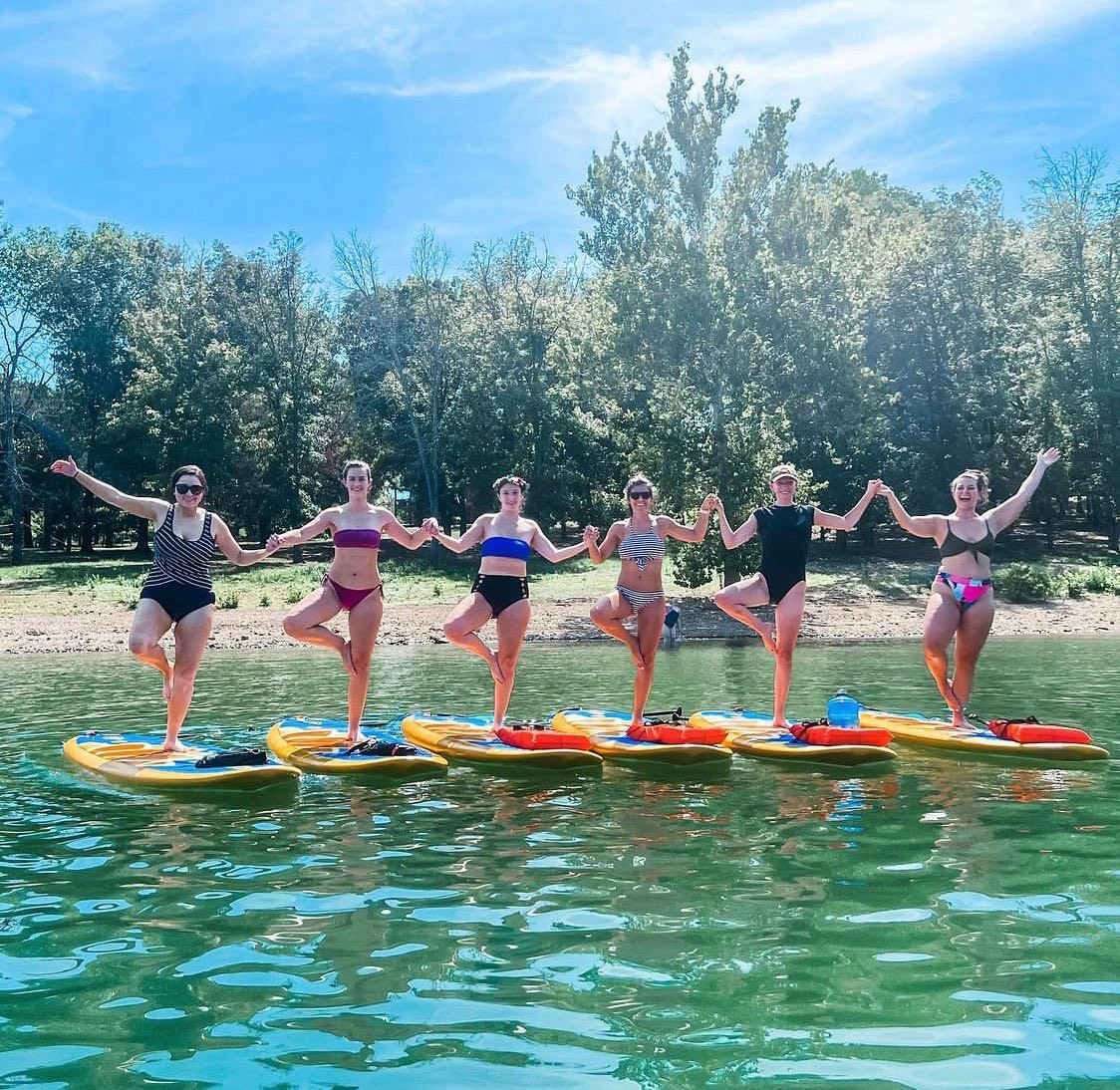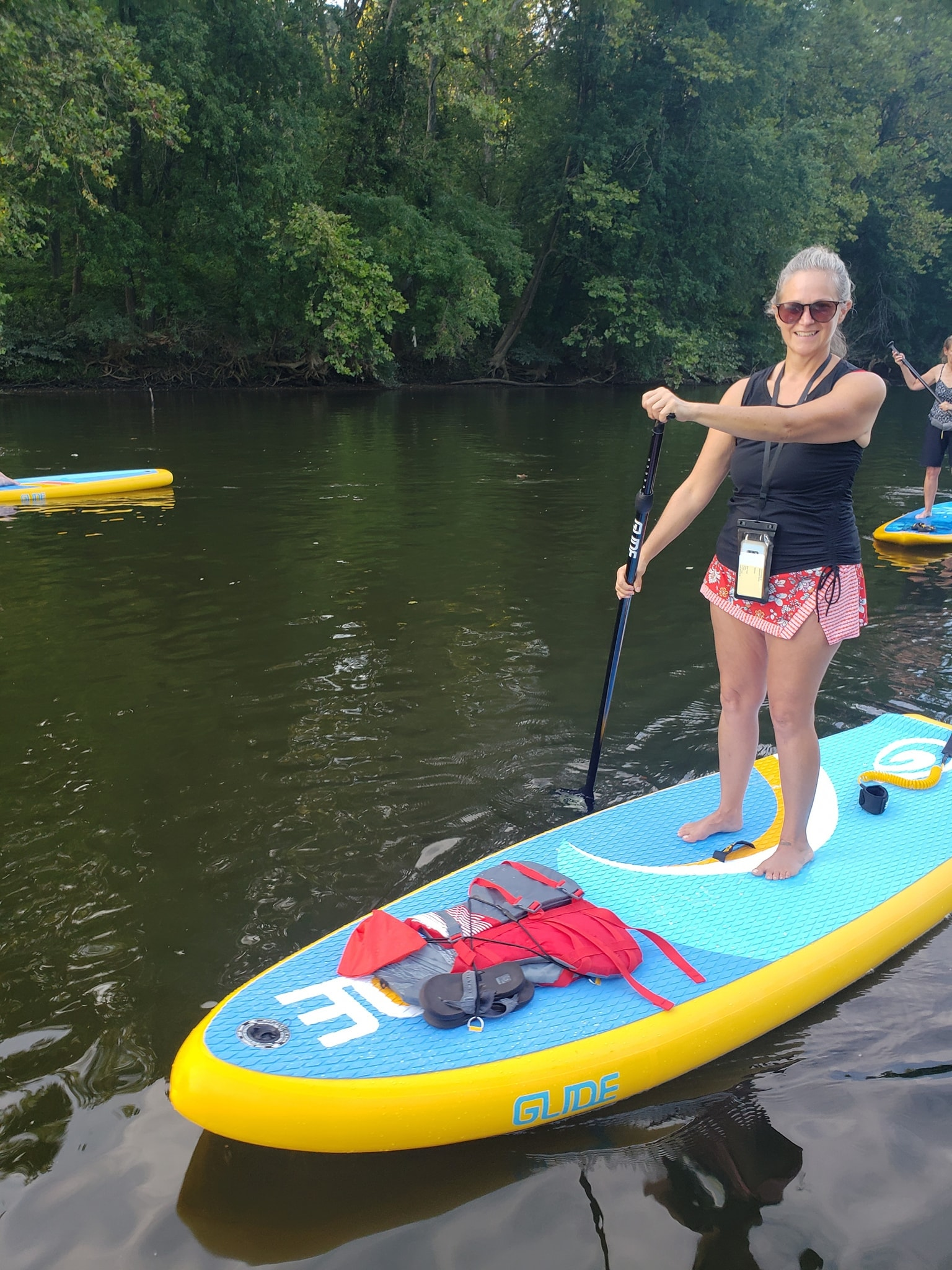
Paddle Board Balance: How SUP Builds Stability and Calm
Use SUP to train balance and calm. Start with a stable board, simple stance cues, and short flatwater sessions, then progress to light chop, easy turns, and low SUP yoga.
SUP is a practical path to better physical and mental balance.
On water, your ankles, knees, hips, and core make constant micro-adjustments while your mind settles into rhythmic, horizon-focused paddling.
Start with a stable board (32–35" wide), a grippy deck pad, and short flatwater sessions.
Use simple cues—eyes up, soft knees, planted blade—and add gentle progressions (light chop, offset stance, easy turns, low SUP yoga).
With consistent 20–30 minute paddles and venue-appropriate safety gear, you’ll feel steadier on the board—and everywhere else.
Table of contents
Good balance powers everything—walking stairs, carrying groceries, even focused thinking. Stand up paddle boarding (SUP) trains balance the way nature intended: gently, continuously, and with feedback from water, wind, and your own breath. Done regularly, SUP sharpens physical stability and cultivates mental ease, whether you’re brand new or leveling up to touring, yoga, or light surf. Read on to learn more about paddle board balance.

Why balance matters (body and mind)
-
Physical balance prevents falls, supports joint health, and improves coordination as we age.
-
Mental balance—clarity, focus, and calm—helps us handle stress and stay resilient.
SUP touches both: the board challenges your body to find center on an ever-moving surface, while the rhythm of paddling encourages mindful presence.
How SUP trains physical balance
-
Unstable surface, stable you: Micro-adjustments at the ankles, knees, and hips constantly reposition your center of gravity over the board’s center of buoyancy.
-
Core engagement: Deep core and hip stabilizers fire to keep your chest quiet while the lower body reacts to chop and wake.
-
Progressive overload—naturally: Flatwater starts easy. Add light breeze, small boat wakes, or gentle current, and your balance system adapts without the grind.
Technique cues that make balance click
-
Stance: feet hip-width over the carry handle, toes forward, soft knees, weight centered.
-
Eyes up: look toward the horizon, not your feet—vision drives stability.
-
Quiet upper body: rotate from the torso for power; avoid side leans during the catch.
-
Blade = balance tool: a planted paddle acts like a third point of contact; keep it in the water during wobbles.
Choosing the right board to support balance
-
Width & volume: 32–35" width and ample volume feel forgiving for beginners; trim down as skills improve.
-
Length: 10'6"–11'6" all-around boards balance stability and glide; touring shapes feel faster once you’re steady.
-
Deck pad: grippy, cushioned pads reduce foot fatigue and boost confidence.
-
iSUP vs. hard board: quality inflatables are durable and forgiving on wakes; hard boards feel a touch more reactive once you’re comfortable.
-
Fin setup: a standard dolphin fin tracks well; slide it back for straighter lines, forward for quicker turns.
SUP for mental balance
-
Rhythmic movement: inhale on the reach, exhale on the exit—link breath to strokes to quiet the mind.
-
Blue space effect: water sights and sounds reduce stress and invite present-moment awareness.
-
Drifting resets: short “drift breaks” between efforts give the nervous system space to downshift.

Balance-building SUP sessions (plug-and-paddle)
-
Foundations (20–25 min)
-
Warm up on knees → stand near shore.
-
4× (2 min easy strokes + 1 min slow “silent” strokes: no splash on entry).
-
Finish with 4 gentle sweep turns per side.
-
-
Stability ladder (25–30 min)
-
5 min steady → 3 min light chop/wake crossing → 2 min drift.
-
Repeat 3×, staying relaxed through knees and ankles.
-
-
Balance + mindfulness (20 min)
-
6 breaths drifting → 2 min easy paddle (match breath to strokes).
-
Repeat 5×; end with 2 minutes eyes-soft focus on the horizon.
-
-
SUP yoga sampler (15–20 min, flatwater)
-
Cat–cow kneeling, low lunge, half split, seated twist, sphinx, child’s pose.
-
Keep moves low and slow; prioritize breath over range of motion.
-
Progressions that won’t overwhelm
-
Surface: flat → light wind ripple → small boat wake lines.
-
Stance: neutral → slight offset (front foot half-step forward) → micro step-backs for turns.
-
Tasks: cruising → buoy turns → short holds (3–5 breaths) in simple yoga shapes.
-
Duration: 15–20 minutes at first; add 5 minutes weekly as comfort grows.
Simple off-water balance boosters
-
Single-leg balance while brushing teeth (eyes forward, 30–45 seconds each side).
-
Heel-to-toe line walks, slow and controlled.
-
Mini squats holding a paddle overhead (neutral spine).
-
Calf/ankle mobility with a band to keep feet springy on deck.
Safety and comfort
-
PFD always; leash matched to venue (coiled flat/open water, straight surf, quick-release waist for rivers/current).
-
Hydration, sun protection, and quick “reset” breaks when legs fatigue.
-
Choose calmer hours (sunrise/golden hour) and shoreline routes with easy exits.

Final Thoughts
Balance is a skill—trainable, rewarding, and worth protecting for life. SUP is a pleasant way to practice it: you’ll feel the body stabilize, the mind settle, and confidence grow session by session. Pick a stable board, keep sessions short at first, and let the water teach. Mastery isn’t the goal—consistency is.
FAQs
What board width is best for learning balance?
Start around 32–35 inches wide. Narrow later if you want more glide or speed.
I look down and wobble—how do I stop?
Fix your gaze on the horizon, soften your knees, and plant the blade early. Vision up = steadier balance.
How often should I paddle to improve balance?
2–3 short sessions (20–30 minutes) per week build stability quickly.
Can SUP yoga help my balance?
Yes—low, controlled sequences on calm water deepen core control and body awareness.
My feet get tired—any tips?
Shift weight slightly every few minutes, wiggle toes, and try a cushioned, grippy deck pad.
Is an inflatable board stable enough?
Good iSUPs are very stable and forgiving; inflate to the recommended PSI for stiffness.
How do I practice turning without losing balance?
Use a planted blade as a brace, take a tiny step back, and keep knees soft during sweep strokes.
I’m older—safe to start?
With a stable board, PFD, and calm water, yes. Start short, stay near shore, and progress gradually.
What if it’s windy?
Hug the shoreline, switch to a slight offset stance, shorten strokes, or postpone—balance suffers in gusts.
Do I need special shoes?
Barefoot is common. If you prefer shoes, choose flexible, grippy water footwear with thin soles.





